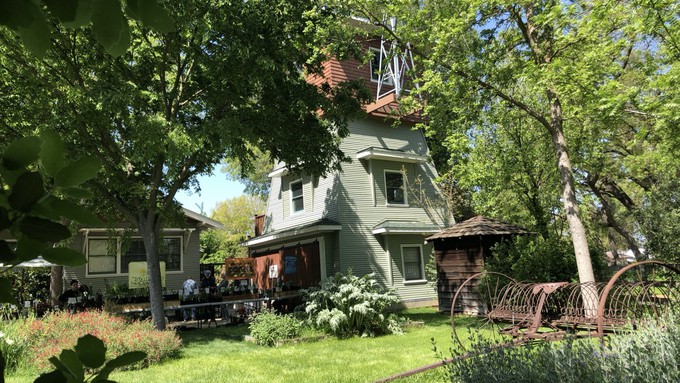
Find member-grown perennials, natives, succulents, vegetables, herbs and more

The historic Azevedo-Moll tank house in South Natomas will be open for tours during the Perennial Plant Club sale on the site. Kathy Morrison
Spring has everybody’s green thumbs itching for action. But what to plant?
The Sacramento Perennial Plant Club has hundreds of suggestions as it hosts its annual spring sale Friday and Saturday, April 12 and 13, in South Natomas. The Natomas Garden & Arts Collective is co-sponsor of the two-day event.
Find California natives, succulents, perennials, vegetables (including lots of tomatoes), herbs and many other plants – all grown by local club members. “Our amazing, hard-working propagators are supplying sun-to-shade loving perennials, natives, veggies, spring-blooming bulbs and more!” say the organizers.
The sale will be open from 9 a.m. to 1 p.m. both days on the grounds of the historic Azevedo-Moll House, 1911 Bannon Creek Drive, South Natomas, Sacramento. Admission is free and open to the public.
During the event visitors can tour the restored tank house on the property. Tours also will be given of the nearby Grassland Garden Pollinator Habitat Project at specific times: 12:30 p.m. on Friday and 11 a.m. Saturday.
Also during the sale "Stan the Tool Man" will offer kitchen and garden tool sharpening, plus container drilling (holes for pots for those new plants, for example). Glass and yard art will be for sale, and food vendors will offer cinnamon rolls and pierogies. Accompanying all this activity will be Native American flute music.
Some of the rare plants available are particular favorites of club members. For example, Patricia Carpenter grew variegated figwort for the sale. “It is very showy in her garden and often weaves through other plants,” say the organizers. “She uses the leaves in cut bouquets. Its reddish flowers are small and interesting.”
Daisy Mah propagated a pale pink hollyhock gifted to her by fellow club member Therese Ruth along with a back story: The original seedling had been abandoned after a Shepard Center sale and planted next to the center’s parking lot, where it bloomed for six months. Daisy named the hollyhock ‘Shepard’s Pink.’
Looking for natives? For this sale, Marla McLaren grew Woolly Indian Paintbrush, a beautiful low-water native that thrives in her garden. “It provides winter color and is a late winter/spring source of food for butterfly and moth pollinators,” say the organizers. Lorraine Van Kekerix contributed her beloved Douglas iris, which thrives in shady spots with limited summer water.
Abutilon lovers will find a whole forest of flowering maples including ‘Lucky Lantern Yellow,’ grown by LaVille Logan. It’s a dwarf variety that stays under 2 feet tall and wide, thrives in partial shade and attracts bees, butterflies, hummingbirds.
Details: https://sacplants.org/.
-- Kathy Morrison contributed to this post
Comments
0 comments have been posted.Sacramento Digs Gardening to your inbox.
Food in My Back Yard Series
May 13: Your plants can tell you more than any calendar can
May 6: Maintain soil moisture with mulch for garden success
April 29: What's (already) wrong with my tomato plants?
April 22: Should you stock up on fertilizer? (Yes!)
April 15: Grow culinary herbs in containers
April 8: When to plant summer vegetables
April 1: Don't be fooled by these garden myths
March 25: Fertilizer tips: How to 'feed' your vegetables for healthy growth
March 18: Time to give vegetable seedlings some more space
March 11: Ways to win the fight against weeds
March 4: Potatoes from the garden
Feb. 25: Plant a fruit tree now -- for later
Feb. 18: How to squeeze more food into less space
Feb. 11: When to plant? Consider staggering your transplants
Feb. 4: Starting in seed starting
Sites We Like
Garden Checklist for week of May 11
Make the most of the lower temperatures early in the week. We’ll be back in the 80s by Thursday.
* Plant, plant, plant! It’s prime planting season in the Sacramento area. Time to set out those tomato transplants along with peppers and eggplants. Pinch off any flowers on new transplants to make them concentrate on establishing roots instead of setting premature fruit.
* Direct-seed melons, cucumbers, summer squash, corn, radishes, pumpkins and annual herbs such as basil.
* Harvest cabbage, lettuce, peas and green onions.
* In the flower garden, direct-seed sunflowers, cosmos, salvia, zinnias, marigolds, celosia and asters. (You also can transplant seedlings for many of the same flowers.)
* Plant dahlia tubers.
* Transplant petunias, marigolds and perennial flowers such as astilbe, columbine, coneflowers, coreopsis, dahlias, rudbeckia and verbena.
* Keep an eye out for slugs, snails, earwigs and aphids that want to dine on tender new growth.
* Feed summer bloomers with a balanced fertilizer.
* For continued bloom, cut off spent flowers on roses as well as other flowering plants.
* Add mulch to the garden to maintain moisture. Mulch also cuts down on weeds. But don’t let it mound around the stems or trunks of trees or shrubs. Leave about a 6-inch-to-1-foot circle to avoid crown rot or other problems.
* Remember to weed! Pull those nasties before they set seed.
* Water early in the day and keep seedlings evenly moist.